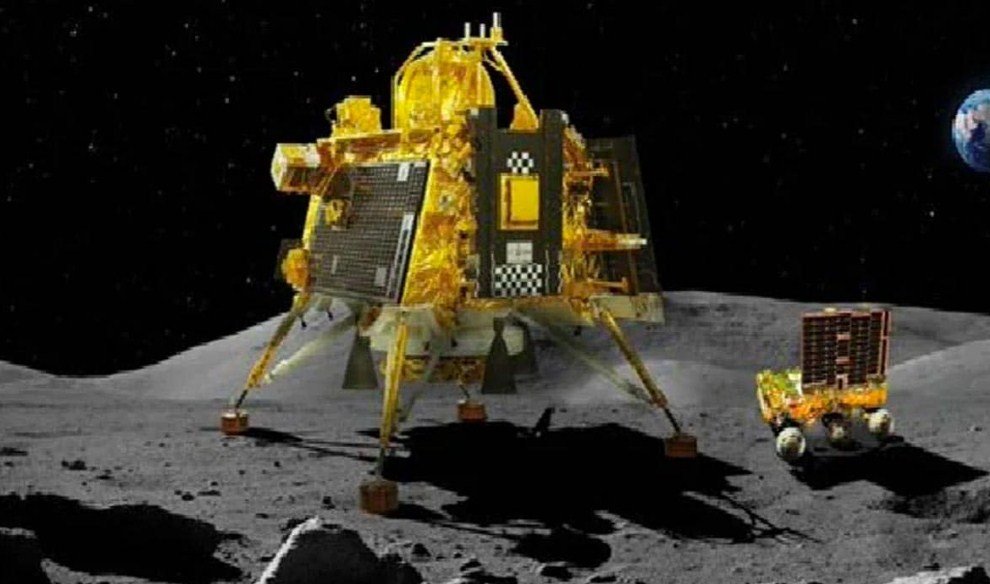India has achieved a historic feat in space exploration by becoming the first country to land a spacecraft on the lunar south pole region. The Chandrayaan-3 mission, launched by the Indian Space Research Organisation (ISRO) on July 14, 2023, successfully touched down on the moon’s surface at 6.04 PM IST on August 23, 2023.
Chandrayaan-3: A follow-up mission to Chandrayaan-2
Chandrayaan-3 is a follow-up mission to Chandrayaan-2, which attempted a soft landing on the moon in September 2019 but failed due to a technical glitch. Chandrayaan-2, however, managed to place an orbiter around the moon, which is still functioning and providing valuable data.
Chandrayaan-3 consists of a lander named Vikram and a rover named Pragyan, both of which are identical to those of Chandrayaan-2. The mission also carries a passive experiment module provided by NASA, which will measure the distance between the lander and the orbiter using laser ranging.
The primary objectives of Chandrayaan-3 are to demonstrate safe and soft landing on the lunar surface, to explore the south pole region for signs of water ice and other resources, and to conduct on-site scientific experiments using the instruments on board the lander and the rover.
Why the south pole region is important
The south pole region of the moon is of great scientific interest because it is permanently shadowed by craters and mountains, creating extremely cold conditions that could preserve water ice and other volatile substances. The presence of water on the moon would have implications for future human exploration and settlement, as well as for understanding the origin and evolution of the moon and the solar system.
The south pole region also offers a unique vantage point for observing the earth and other celestial bodies. The lander and the rover will communicate with the orbiter and the earth using high-gain antennas that can relay data and images.
How Chandrayaan-3 achieved the landing
The Chandrayaan-3 mission was launched from the Satish Dhawan Space Centre in Sriharikota using a GSLV Mk III rocket. The orbiter injected the lander-rover module into a lunar transfer trajectory, which took about 40 days to reach the vicinity of the moon.
The lander then separated from the orbiter and performed a series of orbit maneuvers to lower its altitude and align itself with the landing site. The landing site was chosen based on high-resolution images and data from Chandrayaan-2’s orbiter and NASA’s Lunar Reconnaissance Orbiter.
The lander then initiated a powered descent phase, which lasted for about 15 minutes. During this phase, the lander used its four throttleable engines to control its speed and direction, while avoiding obstacles and hazards on the surface using its onboard sensors and cameras.
The lander successfully touched down on a flat plain between two craters named Manzinus C and Simpelius N, at a latitude of about 70 degrees south and a longitude of about 23 degrees east. The landing was confirmed by telemetry signals received by ISRO’s ground stations and by NASA’s Deep Space Network.
The rover then deployed from the lander using a ramp and began its exploration of the surrounding area. The rover has six wheels and can travel up to 500 meters from the lander. It carries two cameras, an alpha particle X-ray spectrometer, a laser-induced breakdown spectroscope, and a passive thermal probe.
How India celebrated the achievement
The successful landing of Chandrayaan-3 was greeted with jubilation and pride by Indians across the world. Prime Minister Narendra Modi hailed it as a “joyous occasion” of great success and said “this success belongs to all humanity”. He also praised ISRO for its resilience and innovation in overcoming the challenges of the previous mission.
ISRO Chairman K Sivan congratulated his team for their hard work and dedication in making Chandrayaan-3 a reality. He said that Chandrayaan-3 is not only a technological achievement but also a scientific milestone that will enhance our understanding of the moon.
Business leaders from various sectors also expressed their admiration for ISRO’s lunar feat. Anand Mahindra, chairman of Mahindra Group, tweeted that “having the moon in our grasp will spark new dreams in the minds of 1.4 billion Indians”. Gautam Adani, founder of Adani Group, called ISRO “the pride of the nation” and said that “this is India’s time”. Anil Agarwal, founder of Vedanta Resources, said that “India has shown its prowess in space exploration”.
International leaders and agencies also congratulated India for its achievement. Bill Nelson, NASA’s administrator, said that “NASA applauds ISRO’s incredible efforts on Chandrayaan-3” and that “we look forward to working together on our shared lunar aspirations”. Josef Aschbacher, the director general of the European Space Agency, said that “ESA congratulates ISRO for the successful landing of Chandrayaan-3 on the moon’s south pole” and that “we are proud to be a partner in this mission”.
Chandrayaan-3 is expected to operate for at least one lunar day, which is equivalent to 14 earth days. It will continue to send data and images to the orbiter, which will relay them to the earth. The orbiter has a lifespan of about seven years and will continue to orbit the moon and conduct scientific observations.

